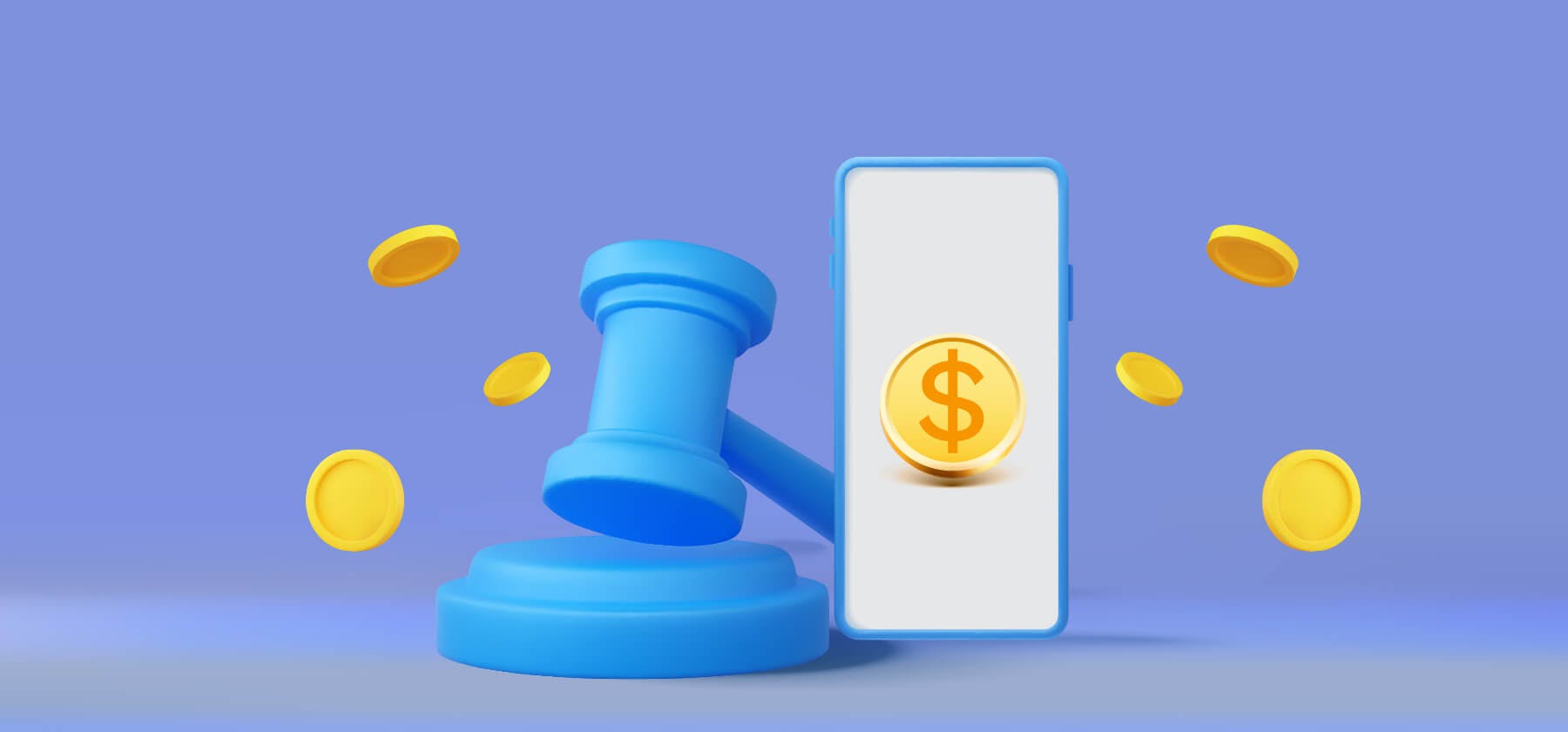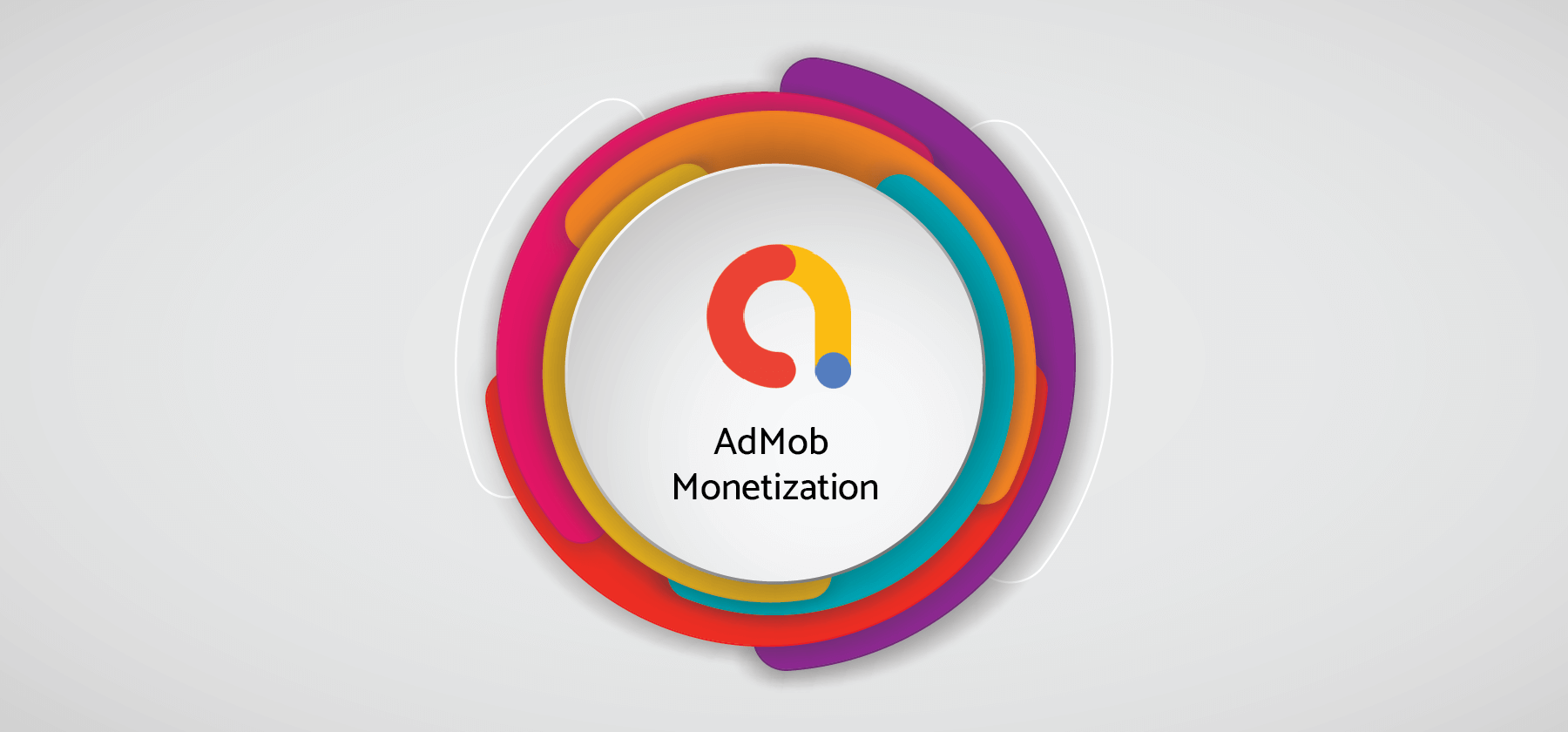- This complete guide will help you understand in-app unified auction in depth by outlining its key metrics, advantages, challenges, and how it works. It will also discuss the technical requirements for implementation and how it integrates with DSPs and SSPs.
- Finally, we will compare in-app unified auction to waterfall, private auction, and header bidding before looking at its future potential.
Publishers are finding it more challenging to monetize their apps as mobile viewership habits continue to concentrate on a limited number of significant properties. What, then, is the solution? How do apps become successful? In-app Unified Auctions may provide many with the answer to their monetization problems.
Google changed Ad Manager to allow in-app unified auction operations and a seamless switch to the first-price auction model. As a result of this modification, programmatic buyers' offers compete in the same auction with directly agreed-upon inventory with advertisers.
Publishers and app developers find it more straightforward to manage and get fair value for their inventory if the auction process in the ad manager is simplified. For a better understanding, let's examine what an in-app unified auction is in more detail.
What is In-app Unified Auction
Multiple demand sources (such as SSPs, DSPs, or ad exchanges) can contend for the same ad space together using the in-app unified auction programmatic technique.
Publishers can offer their ad inventory to several buyers at once through in-app unified auctions.
All associated ad networks, ad exchanges, and advertisers have the chance to place a bid on the publisher's inventory during an in-app unified auction. The bid request is sent simultaneously to each of these partners. The winning bidder is then decided upon by the ad server, who also grants them the ad impression.
Instead of executing multiple DSP- or exchange-level auctions and then sending the winning bids to the ad server, the objective is to run a single auction. In addition to giving publishers access to new demand sources, an in-app unified auction utilizes the first-price mechanism to boost yield.
In-app Unified Auctions Key Metrics
Publishers and advertisers may assess the success of their ad campaigns and fine-tune their techniques to increase revenue and engagement with the help of in-app unified auction key metrics. They can refine their bidding strategies and boost the effectiveness of their campaigns by keeping an eye on metrics like eCPM, fill rate, viewability rate, CTR, and ad quality score.
Following is a description of some of the crucial metrics used in in-app unified auctions:
-
eCPM: eCPM is an estimation of the revenue yielded from 1000 impressions. To calculate it, divide the whole sum of ad revenue by the total number of impressions and then multiply the result by 1000.
eCPM = (Total ad revenue / Total number of impressions) x 1000
eCPM allows publishers and advertisers to evaluate the success of their campaigns and to compare them to one another.
-
Fill rate: The percentage of successfully filled ad requests is known as the fill rate. It is determined by dividing the total number of provided ad impressions by the total number of ad requests.
Fill rate = (Total number of ad impressions / Total number of ad requests)
A high fill rate suggests that a publisher's inventory is in high demand, whereas a low fill rate can indicate that the inventory is less in demand or that the campaign is not optimized.
-
CTR (Click Through Rate): CTR is the proportion of users who click on an ad after seeing it. You may compute it by dividing the number of clicks by the number of impressions.
CTR = (Total number of clicks / Total number of impressions)
CTR helps advertisers and publishers measure the effectiveness of their ad creatives and optimize their campaigns to improve engagement.
-
Ad Viewability Rate: The percentage of user-viewed ad impressions is known as the ad viewability rate. You may calculate it by dividing the number of viewed impressions by the total number of impressions.
Ad Viewability Rate = (Viewed impressions / Total number of impressions) x 100
Advertisers and publishers can optimize their campaigns with ad viewability rates to measure the visibility of their ads.
-
Ad Quality Score: The ad quality score is a measure of how effectively an advertisement fulfills the user's and the publisher's necessities. It is determined using criteria including relevancy, effectiveness, and user experience. With the help of ad quality scores, publishers and advertisers can ensure high-caliber ads relevant to the target market.
How In-app Unified Auctions Work
Each demand partner can place a bid simultaneously in a single auction during a unified in-app auction. This strategy significantly increases competition and maximizes your CPMs and revenue because everyone is bidding simultaneously.
Responding to each request, each partner participates and makes their highest bid. With this cutting-edge yield optimization, you can be confident that every auction will net you the highest price possible as a publisher.
One ad call is all that is essential for in-app unified auctions, which decreases latency, and boosts fill rates and revenue.
Some demand partners can have a "first look" at the impressions using other alternatives, such as waterfall auctions, before deciding to purchase them. Because of this, publishers won't always get paid the highest price for their ad space.
How to Implement In-app Unified Auction
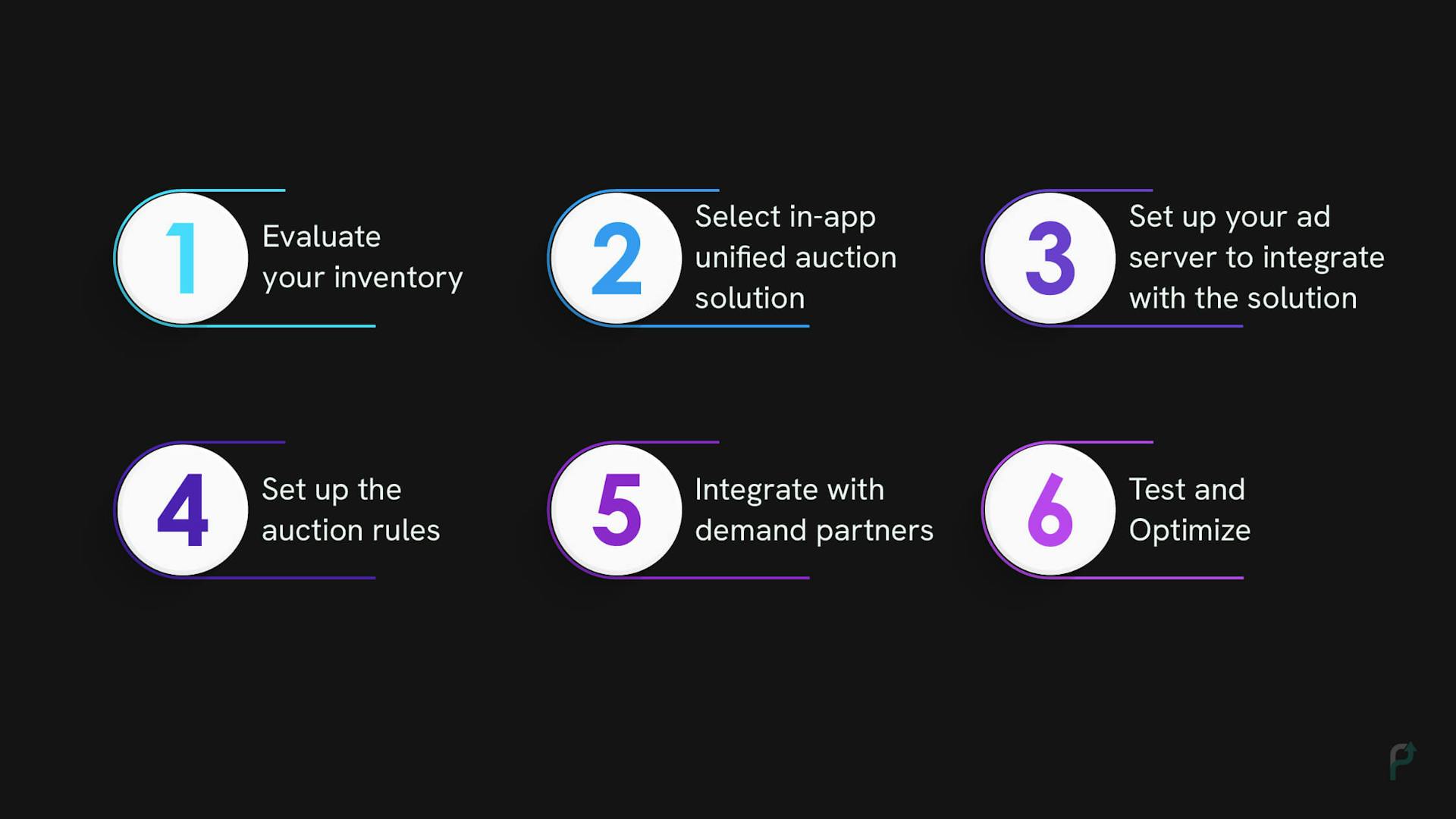 How to implement in-app unified auction
How to implement in-app unified auctionThe following six general phases must be considered before implementing an in-app unified auction:
- Evaluate your inventory: Firstly, determine which ad units and placements are the most lucrative and in demand by evaluating your inventory. This will help in inventory optimization and setting up appropriate pricing.
- Select in-app unified auction solution: Depending on your requirements and spending limit, select an in-app unified auction solution. For instance, Google Ad Manager.
- Set up your ad server to integrate with the solution: Set up your ad server to integrate with the in-app unified auction solution. This includes making ad placements, setting up the ad server, and establishing ad tags.
- Set up the auction rules: Next, set up the in-app unified auction's bidding rules. To do this, you must implement bidder access controls, priority levels, and price floors.
- Integrate with demand partners: Sync up with demand partners, such as SSPs and DSPs. Setting up bidder accounts and defining bid parameters are required for this.
- Test and Optimize: To ensure the smooth operation of the auction and deliver the required results, test and optimize it. In order to do this, significant metrics like eCPM, fill rate, ad viewability rate, and CTR must be closely monitored and adjusted as necessary.
Technical Requirements for putting In-app Unified Auctions in Place
A few technical requirements to implement an in-app unified auction and guarantee the platform's proper operation are:
- Ad Server Integration
- Bidder Integration
- Real-time Bidding Protocol Support
- Data Management and Targeting
- Reporting and Analytics
- Security and Fraud Prevention
- API and SDK Support
-
Ad Server Integration: For the in-app unified auction platform to receive ad requests and provide responses to winning bidders, you must integrate your ad server.
-
Bidder Integration: In order to receive bid requests and issue bid responses, you must integrate your bidders with the in-app unified auction platform.
-
Real-time Bidding(RTB) Protocol Support: Real-time bidding and data communication amongst demand partners require the in-app unified auction platform to implement RTB protocols.
-
Data Management and Targeting: The platform should offer data management features (such as audience targeting) to improve the performance and relevancy of the ads.
-
Reporting and Analytics: For publishers and buyers to inspect auction results and improve their bidding tactics, the in-app unified auction platform should include extensive reporting and analytics tools.
-
Security and Fraud Prevention: Ad fraud prevention and malicious activity defense must be in place on the platform with robust security features.
-
API and SDK Support: The platform should include API and SDK to make it simple to integrate with other ad tech solutions and to allow for bespoke development.
How to Integrate In-app Unified Auction with DSPs and SSPs
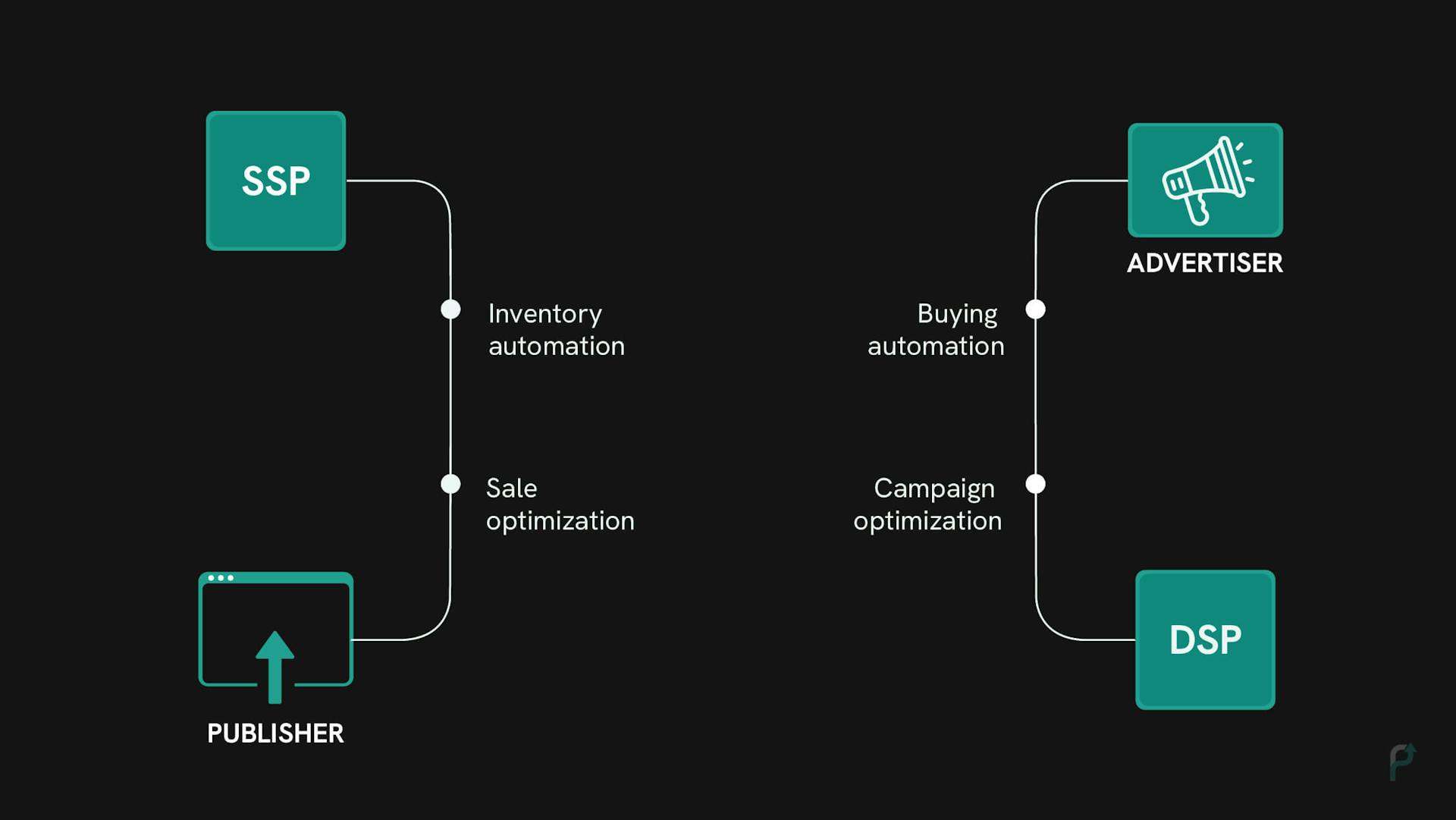 In-app Unified Auction Integration
In-app Unified Auction IntegrationThe programmatic technology platforms DSPs and SSPs make it possible to buy and sell programmatic ads. An in-app unified auction must include integration with DSPs and SSPs.
SSP and DSP integration into your in-app unified auction can help you stay competitive and boost revenue from your ad inventory, whether you're a small publisher aiming to boost sales or a major publisher with complex advertising requirements.
Detailed planning, technical know-how, and continuing optimization are essential for a successful DSP and SSP integration.
In order to maximize the competition and revenue for publishers, the in-app unified auction platform should serve both sides' needs (SSPs and DSPs), including the bid request and response format, the RTB protocol, ad formats, channels, etc.
The integration process may differ based on the specific solutions you pick. Therefore, it's critical to review the documentation and support materials offered by each vendor.
Here are Some Helpful Pointers for Implementing In-app Unified Auctions
- To increase competition and revenue, make sure to incorporate a variety of demand sources.
- To ensure a fair and open auction process, clearly define the rules and regulations for bidders and sellers.
- You must consistently review and tweak your auction settings to improve performance and boost revenue.
- Confirm that the auction platform is compatible with all of the ad formats and channels you plan to offer in the auction.
- Setting up pricing floors and maximizing demand sources are all part of managing your demand partners efficiently.
- To find concerns and make improvements, keep an eye on how well your in-app unified auctions are doing.
- Make sure to select demand partners who can execute the needed results, are trustworthy, and have a proven track record.
- Improve user experience by optimizing your in-app unified auctions, which includes cutting down on latency and ad clutter.
Benefits of In-App Unified Auction for Publishers
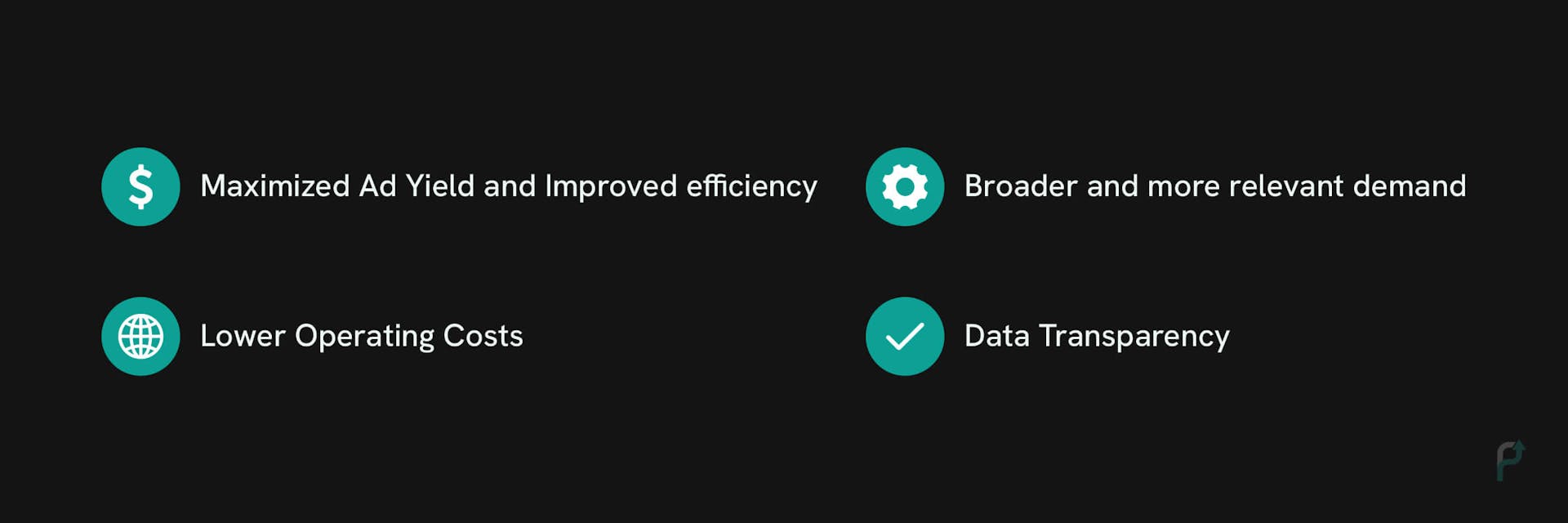 Benefits of In-app Unified Auction for Publishers
Benefits of In-app Unified Auction for Publishers-
Maximized Ad Yield and Improved efficiency
The two primary sources of revenue for free apps are in-app purchases and advertising. For certain apps, ad revenue might exceed 90% of total revenue. Developers sometimes use mediation waterfalls to manage multiple app monetization platforms to maximize this revenue.
But as waterfalls represent the historical average eCPM performance of each monetization partner, sequential ad serving creates barriers to maximizing yield. On the other hand, in-app unified auctions conduct auctions based on CPM rates in bid response from demand partners and simultaneously send out ad requests to all engaged demand partners.
By requiring only one ad call, in-app unified auctions reduce latency, boost fill rates, and boost yield by increasing competition for each impression.
The highest bidder for the CPM price will win the auction and get a chance to show the ad. This flattened ad request and auction technique brings more competition at each ad request level, leading to more bids and revenue for the developers.
-
Data Transparency
It can be challenging to understand third-party ad mediation platforms. Sometimes it's unclear which algorithm is applied to predict the eCPM for each demand partner or why impression allocation is handled in a specific way.
You also aren't entirely sure how each ad network values the various app users. For developers, perfect transparency should be possible with in-app unified auctions. You should be able to view the auction-level performance data and understand why this demand partner won the auction over other bidders.
Publishers have access to auction-level information (such as incoming and winning bids) and evaluate the value of their inventory using granular reporting, which allows them to filter data by CPM, impression rates, and other specific performance metrics.
With access to these extra data points, you will have better visibility into the market worth of your inventory. Additionally, you will know which user groups are highly valued than others and by how much.
-
Lower Operating Costs
The waterfall setup can be very demanding to manage. The monetization team must continuously negotiate customized deals, track performance, and modify waterfall positions for demand partners.
The maintenance of the waterfall is made more difficult by some developers who set up many line items or instances for each ad network for a specific app, placement, and country.
Waterfalls might have hundreds or even thousands of line item alternatives for some developers. By conducting simultaneous auctions with all involved demand partners, in-app unified auctions significantly save a ton of time for your monetization team.
Daily operations of the monetization team became significantly simpler after implementing in-app unified auctions. No more adjusting the waterfall manually.
-
Broader and more relevant demand
Performance ads, particularly gaming performance ads, are frequently seen in the monetized games of game companies.
Users' ad fatigue or users switching to other gaming apps are two issues that developers frequently worry about.
A growing requirement for game developers seems to be brand advertising. With in-app unified auctions, brand DSPs may compete with traditional ad networks for profitable mobile app audiences.
Comparatively, to traditional performance advertisers, specific subgroups of mobile app users may be considered much more lucrative by brand advertisers. The advantage of implementing in-app unified auctions is that brand advertisements are more dominant in apps, especially during the most active shopping seasons.
Publishers can access multiple demand sources, such as DSPs, advertisers, and ad networks with in-app unified auctions. Further, a better user experience is ensured by higher CPM rates because more demand sources allow publisher websites to display more relevant ads.
Additionally, without having to share their bid price with ad networks and exchanges, advertisers are given an equal opportunity to participate in the auction.
Benefits of In-App Unified Auction for Advertisers
The biggest concerns for advertisers are duplicate supply and fragmented mobile in-app inventory. Because of these factors, mobile advertisers find in-app unified auctions fascinating.
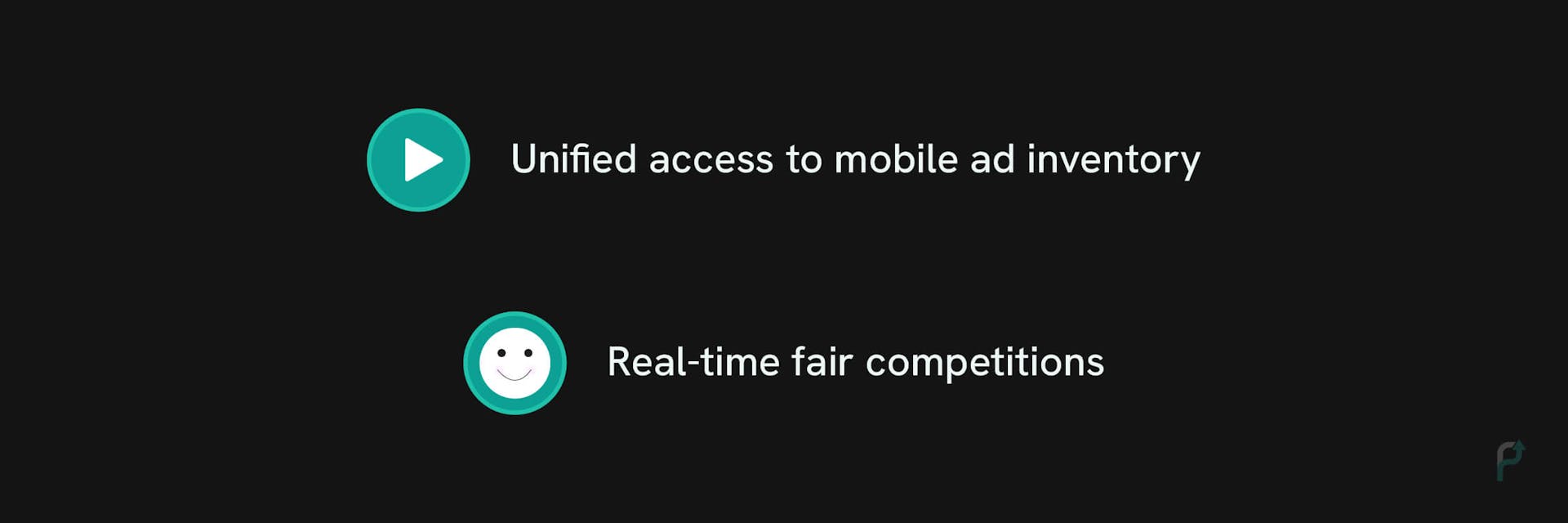 Benefits of In-app Unified Auction for Advertisers
Benefits of In-app Unified Auction for AdvertisersUnified access to mobile ad inventory
Complex mediation waterfalls make it difficult for advertisers to find typical supply sources, specifically for programmatic buyers.
DSPs frequently get identical bid requests from many exchanges. Additionally, they(DSPs) have limited access to premium mobile app inventory, and traditional ad network players can often capture the mobile in-app impressions.
These programmatic purchasers' supply path optimization method works perfectly with in-app unified auctions. Through in-app unified auctions, they may prioritize the inventory and cut down on duplicate inventory. Additionally, they are given unified access to mobile app inventory on an equal playing field with traditional ad network competitors.
As a new in-app monetization solution, unified auctions have several advantages for both publishers and advertisers.
Real-time fair competitions
A demand partner may spend a lot of time stuck at lower waterfall positions and may find it challenging to ascend the waterfall.
The simple reason for this could be that over the past seven days, their average eCPM wasn't competitive enough. However, this demand partner might currently have tremendous demand and be eager to offer too high CPMs.
They might not be able to pay so high a CPM when it is their turn to display ads because they are at the bottom of the waterfall.
Everyone is treated equally in in-app unified auctions. At the same time and reasonably, all demand partners take part in the real-time auction. The winning bidder is the one who offers the highest price.
Advertising partners compete on an equal footing, and no demand partner gets undercover preferred treatment over another.
What are the Challenges of In-app Unified Auction
Despite all the advantages in-app unified auctions might offer, some complications do exist.
Some of the challenges of In-app Unified Auctions:
- Ad fraud
- Complexity
- Bidder Competition
-
Ad Fraud Given that publishers may not have complete visibility into where and how their ads are displayed, in-app unified auctions can raise the risk of ad fraud and lower ad viewability rates.
-
Complexity The technical implementation of in-app unified auctions can be challenging and expensive. Smaller publishers or those with fewer technological resources may find this a hindrance.
-
Bidder Competition Managing the competition and ensuring that the highest bidder wins without overpaying might be complicated, with multiple bids participating in the auction.
In-app Unified Auctions vs. Waterfall Auction
To understand the primary differences between in-app unified auctions and waterfall auctions, let's discuss each type of auction separately.
Waterfall Auctions
A waterfall system needs the publisher to present their inventory to one ad network at a time, initiating from the best performing to the lowest until the impression gets sold.
This arrangement shows priority to the networks at the top of the waterfall, facilitating them to see the minimal floor that has been set and pick which impressions they would like to buy, even if another demand partner is willing to pay a higher price. If they deny, the subsequent partner in line gets the pick, and this is called "Passback". Because each network needs a separate ad call, passbacks add to latency. Your overall revenue decreases due to latency, which also affects fill rates.
The waterfall was formed as an easy-to-use, creative solution in the early days of mobile advertising when single ad networks lacked sufficient inventory.
To guarantee they could fill every ad spot, publishers required a mechanism to connect to several networks. In its simplest form, a waterfall simply goes down a list. The waterfall advances to the next network in the list if a network has no inventory to supply.
Waterfalls have evolved, becoming more complicated while also acquiring some downsides.
A waterfall needs ongoing upkeep and adjusting in the ad marketplace because performance might change every day. Additionally, since most publishers must devise their own analytics infrastructure, data is gathered from hundreds of networks. Further, waterfalls' sequential nature means that the available ad slots may take a while to fill.
Afterward, in-app unified auctions emerged. Similar to waterfalls, in-app unified auctions started with a straightforward idea; instead of prioritizing particular ad networks, auction requests are delivered to every network simultaneously for real-time bidding (RTB), and the highest bid wins.
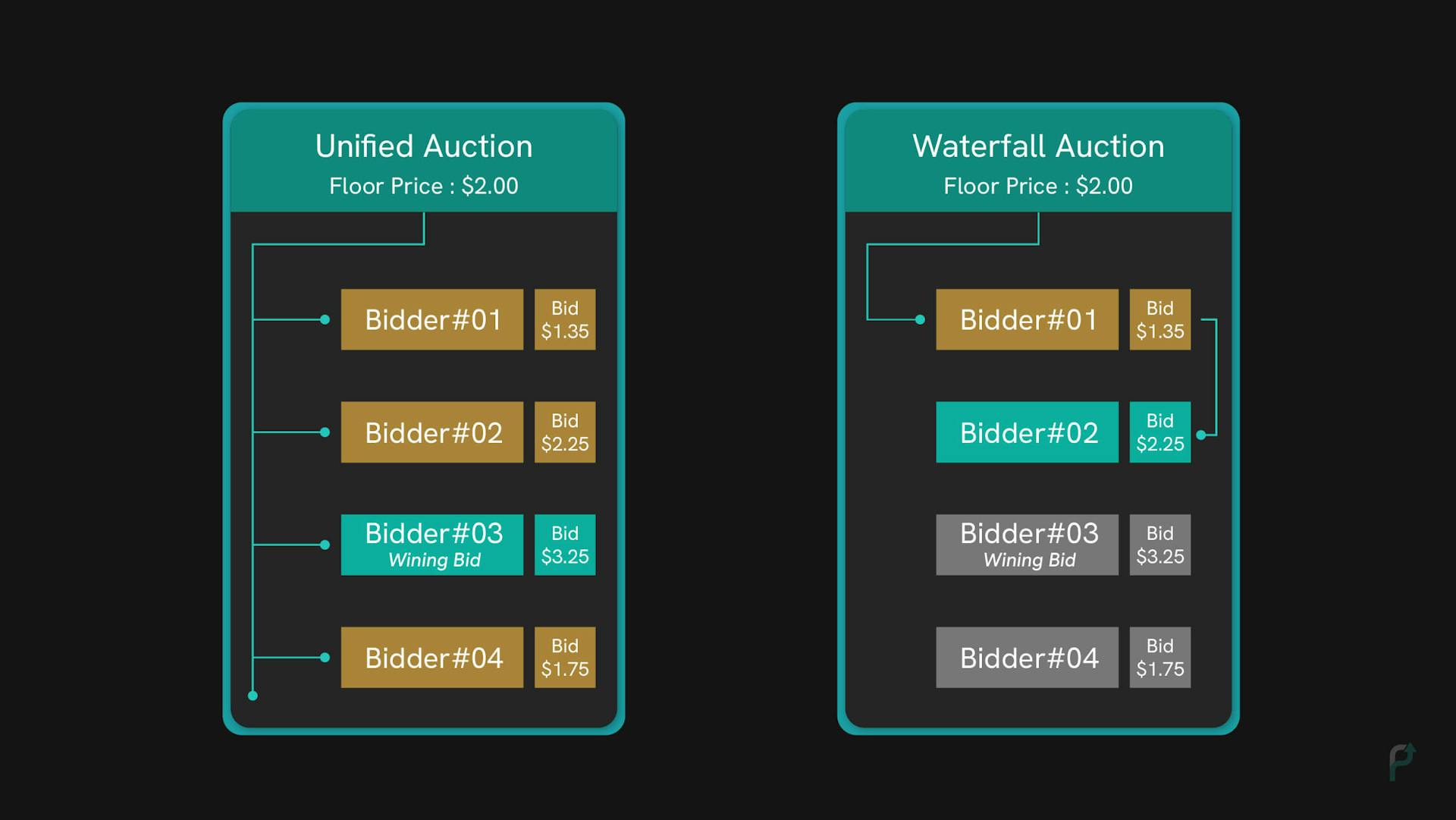 In-app Unified Auction vs Waterfall
In-app Unified Auction vs WaterfallIn-app Unified Auction
All ad networks (and the advertisers they deal with) simultaneously bid on the available inventory for an app during a unified auction.
No network gets preference over another, and the winning bid is frequently the highest one. All networks are alerted to the availability of ad placement as soon as an app is unlocked, and they all put in real-time bids.
There are various benefits to this concept.
The fill rates rise because the entire auction occurs instantaneously. Infact, an in-app unified auction delivers more ad diversity than waterfalls, which favor specific networks and cause viewers to see the same ads repeatedly.
Publishers should avoid creating frequent changes to network orders based on current performance by letting auctions elevate the best offer. Furthermore, in-app unified auction analytics are more straightforward.
Why do Some Publishers Continue to Use Waterfalls
In-app unified auctions may be the ideal solution for some publishers, while others—often the major publishers—prefer to keep control by actively modifying and improving their waterfalls.
Many publishers still favor waterfalls even though unified auctions seem more straightforward. Despite its benefits, automating in-app unified auctions involves far more refined technology than a waterfall.
Waterfalls have become a hybrid technology that can incorporate in-app unified auctions. Some publishers together run their waterfall and in-app unified auctions, selecting the best outcome. Others put auctions as line items within the waterfall, placing a preferred network or direct sale as the first item on the waterfall and an in-app unified auction as the second.
In-app Unified Auctions vs. Private Auctions
Let us understand the primary differences between in-app unified auctions and private auctions.
What are Private Auctions
Only some advertisers are allowed to participate in private auctions. Through this exclusive deal, a select number of advertisers will have priority access to bid on the inventory before it becomes accessible in the public market.
Publishers or ad exchanges can set a minimum CPM, and the impressions will go to the highest bidder.
Comparing Private and In-app Unified auctions
These two programmatic advertising auction techniques have notable differences in the way the auction works and who participates in it.
In in-app unified auctions, programmatic and direct deals are combined with all other demand sources to create a single auction. No matter the source, every bidder places a bid on the inventory at once. As a result, the auction process gets improved and streamlined, which can increase publisher revenue.
Private auctions are programmatic auctions in which only a small group of prospective buyers are encouraged to submit bids for a specific inventory. Programmatic direct deals or preferred deals are used to conduct private auctions.
With this approach, the publisher decides who has access to the inventory, and the invited buyers compete for it in a separate private auction.
Unified and private auctions differ significantly in the following ways:
| Criteria | In-app Unified Auctions | Private Auctions |
|---|---|---|
| Auction Type | Single Comprehensive Auction | Separate and exclusive auctions |
| Inventory | Access to the entire inventory | Limited access to a particular stock |
| Number of buyers | All Buyers | Limited number of Buyers |
| Rules | Uniform auction rules | Publishers can choose their auction guidelines and only invite bidders who fit their requirements. |
| Transparency | Greater transparency due to simultaneous bids from all buyers on the same inventory. | Less transparent since only pre-selected buyers have access to the inventory. |
In-app Unified Auction vs Header Bidding
Let's discuss the critical differences between in-app unified auctions and header bidding.
What is Header Bidding
Publishers can offer their inventory to many ad networks and ad exchanges together through the advanced programmatic approach known as header bidding. This helps publishers boost ad revenue by specifying the maximum price for their inventory.
Comparing Header Bidding and In-app Unified auctions
In-app Unified auctions seem similar to well-known solution header bidding and are one of the essential technologies in the programmatic ecosystem.
Header bidding, on the other hand, selects a bid from several auctions before sending it to the header bidding wrapper. It indicates that several auctions may be running together.
The number of auctions is the primary distinction between header bidding and in-app unified auctions. While in-app unified auctions only feature one auction, header bidding involves multiple auctions.
It is worth noting how In-app Unified Auctions differ from header bidding in terms of how header bidding is implemented in app setups. Even though header bidding has advantages over waterfall bidding, it frequently performs less well than a completely in-app unified Auction.
In-app header bidding only involves a small group of advertisers or ad networks, usually those bidding programmatically. These arrangements allow for simultaneous ad calls, and the results of that call are added to a waterfall with the players not using programmatic.
These header bidding configurations have the following significant drawbacks:
- Two SDKs are required for apps: one for header bidding and the other for non-programmatic partners.
- Participants in the programmatic process receive free access to all inventory at the start.
- As it is presently used at the app level, header bidding does not eliminate the drawbacks of the waterfall.
Are in-app unified auctions the way to app monetization in the future
In the programmatic advertising ecosystem, in-app unified auctions are becoming more and more significant. They give publishers a chance to maximize their ad revenue and promote more competition for their ad inventory.
The advantages of this strategy may outweigh the drawbacks, even though in-app unified auction implementation has some difficulties, such as technical complexity and bidder competitiveness.
Concerns over price, speed, and opportunity cost from waterfalls can only be stopped via in-app unified auctions.
In-app header bidding solutions are more useful but fall short of delivering a comprehensive solution to app monetization concerns. In-app Unified Auctions are the best choice for app developers since they instantly open up all inventory and guarantee that the highest bidder always wins.
In Conclusion
So, even if in-app unified auctions have a promising future, both types of mediation are still useful. It's up to you to choose which is best for your circumstances based on what you value most: control, speed, possibly a little of both.
Publishers can preserve their competitiveness and maximize the revenue potential of in-app unified auctions with careful preparation, the right technological partners, and partner selection.
Frequently Asked Questions
The only ad platform built for developers by developers.
Contact us now for a product that fits your needs! It’s quick, simple and easy.

